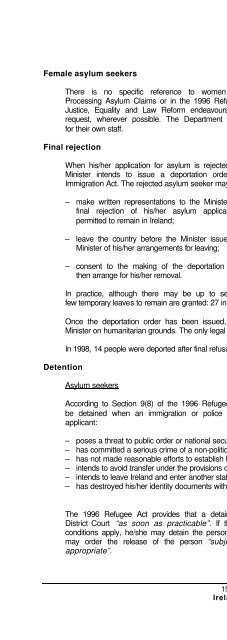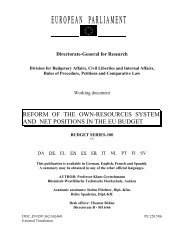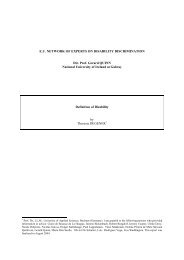legal and social conditions for asylum seekers and refugees in ...
legal and social conditions for asylum seekers and refugees in ...
legal and social conditions for asylum seekers and refugees in ...
You also want an ePaper? Increase the reach of your titles
YUMPU automatically turns print PDFs into web optimized ePapers that Google loves.
Female <strong>asylum</strong> <strong>seekers</strong><br />
There is no specific reference to women applicants <strong>in</strong> either the current Procedures <strong>for</strong><br />
Process<strong>in</strong>g Asylum Claims or <strong>in</strong> the 1996 Refugee Act. The Asylum Division of the Department of<br />
Justice, Equality <strong>and</strong> Law Re<strong>for</strong>m endeavours to provide female <strong>in</strong>terviewers <strong>and</strong> <strong>in</strong>terpreters on<br />
request, wherever possible. The Department have stated that they hope to <strong>in</strong>troduce guidel<strong>in</strong>es<br />
<strong>for</strong> their own staff.<br />
F<strong>in</strong>al rejection<br />
Detention<br />
When his/her application <strong>for</strong> <strong>asylum</strong> is rejected follow<strong>in</strong>g appeal, the applicant is <strong>in</strong><strong>for</strong>med that the<br />
M<strong>in</strong>ister <strong>in</strong>tends to issue a deportation order under the provisions of Section 3 of the 1999<br />
Immigration Act. The rejected <strong>asylum</strong> seeker may then:<br />
– make written representations to the M<strong>in</strong>ister with<strong>in</strong> 15 work<strong>in</strong>g days follow<strong>in</strong>g notification of the<br />
f<strong>in</strong>al rejection of his/her <strong>asylum</strong> application sett<strong>in</strong>g out reasons why he/she should be<br />
permitted to rema<strong>in</strong> <strong>in</strong> Irel<strong>and</strong>;<br />
– leave the country be<strong>for</strong>e the M<strong>in</strong>ister issues the deportation order, but he/she must <strong>in</strong><strong>for</strong>m the<br />
M<strong>in</strong>ister of his/her arrangements <strong>for</strong> leav<strong>in</strong>g;<br />
– consent to the mak<strong>in</strong>g of the deportation order with<strong>in</strong> 15 work<strong>in</strong>g days <strong>and</strong> the M<strong>in</strong>ister will<br />
then arrange <strong>for</strong> his/her removal.<br />
In practice, although there may be up to several thous<strong>and</strong> applicants await<strong>in</strong>g a decision, very<br />
few temporary leaves to rema<strong>in</strong> are granted: 27 <strong>in</strong> 1998 <strong>and</strong> 39 <strong>in</strong> 1999.<br />
Once the deportation order has been issued, it is no longer possible to make an appeal to the<br />
M<strong>in</strong>ister on humanitarian grounds. The only <strong>legal</strong> remedy available at that stage is judicial review.<br />
In 1998, 14 people were deported after f<strong>in</strong>al refusal.<br />
Asylum <strong>seekers</strong><br />
Accord<strong>in</strong>g to Section 9(8) of the 1996 Refugee Act (not yet implemented), an <strong>asylum</strong> seeker may<br />
be deta<strong>in</strong>ed when an immigration or police officer suspects “with reasonable cause” that the<br />
applicant:<br />
– poses a threat to public order or national security;<br />
– has committed a serious crime of a non-political nature outside Irel<strong>and</strong>;<br />
– has not made reasonable ef<strong>for</strong>ts to establish his/her true identity;<br />
– <strong>in</strong>tends to avoid transfer under the provisions of the Dubl<strong>in</strong> Convention;<br />
– <strong>in</strong>tends to leave Irel<strong>and</strong> <strong>and</strong> enter another state il<strong>legal</strong>ly;<br />
– has destroyed his/her identity documents without reasonable cause.<br />
The 1996 Refugee Act provides that a deta<strong>in</strong>ed person shall be brought be<strong>for</strong>e a judge of the<br />
District Court “as soon as practicable”. If the judge is satisfied that any of the a<strong>for</strong>ementioned<br />
<strong>conditions</strong> apply, he/she may deta<strong>in</strong> the person <strong>for</strong> a period of not more than ten days. The judge<br />
may order the release of the person “subject to such <strong>conditions</strong> as he or she considers<br />
appropriate”.<br />
151<br />
Irel<strong>and</strong>
















